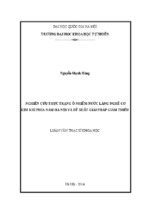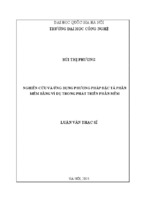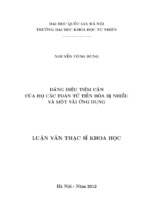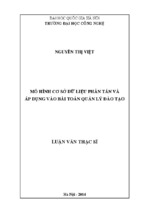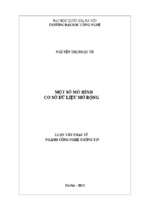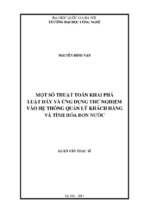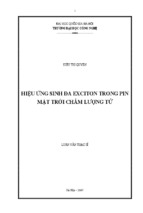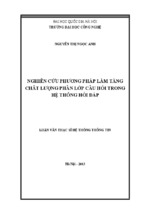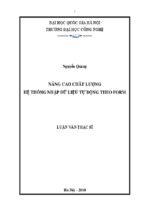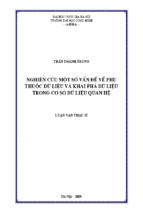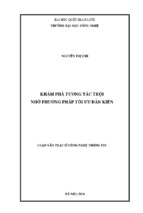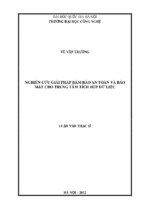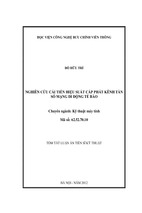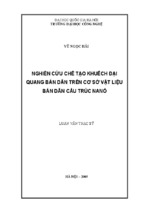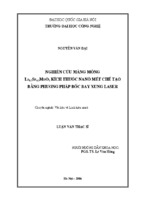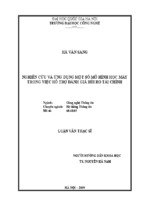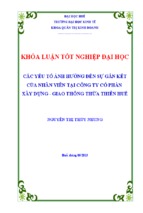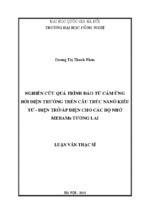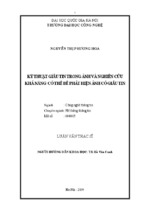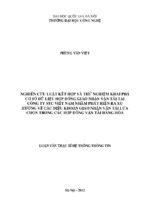VIETNAM NATIONAL UNIVERSITY, HANOI
UNIVERSITY OF LANGUAGES AND INTERNATIONAL STUDIES
FACULTY OF POST - GRADUATE STUDIES
******
ĐỖ THỊ THUẦN
AN EVALUATION OF THE TEXTBOOK “ KID’S BOX 5” FOR
GRADE 5 AT DOAN THI DIEM PRIVATE PRIMARY SCHOOL
(Nghiên cứu đánh giá sách giáo khoa “ Kid’s Box 5” dùng cho
học sinh lớp 5 tại trường Tiểu học Dân lập Đoàn Thị Điểm )
M.A. Minor Programme Thesis
Field:
English Teaching Methodology
Code:
60.140.111
HANOI - 2015
VIETNAM NATIONAL UNIVERSITY, HANOI
UNIVERSITY OF LANGUAGES AND INTERNATIONAL STUDIES
FACULTY OF POST - GRADUATE STUDIES
******
ĐỖ THỊ THUẦN
AN EVALUATION OF THE TEXTBOOK “ KID’S BOX 5” FOR
GRADE 5 AT DOAN THI DIEM PRIVATE PRIMARY SCHOOL
(Nghiên cứu đánh giá sách giáo khoa “ Kid’s Box 5” dùng cho
học sinh lớp 5 tại trường Tiểu học Dân lập Đoàn Thị Điểm )
M.A. Minor Programme Thesis
Field:
English Teaching Methodology
Code:
60.140.111
Supervisor: Hoàng Thị Xuân Hoa, Ph.D
HANOI - 2015
DECLARATION
I hereby declare that all information in this thesis has been obtained and presented
in accordance with academic rules and ethical conduct. I also declare that, as
required by these rules and conduct, I have fully cited and referenced all material
and results that are not original to this work.
Signature
Do Thi Thuan
i
ACKNOWLEDGEMENTS
First and foremost, I would like to express my deepest gratitude and appreciation to
Dr. Hoang Thi Xuan Hoa, my supervisor, for her guidance, advice, criticism,
encouragements and insight throughout the research.
I would like to show my gratitude to all lecturers of the Faculty of Post - Graduate
Studies, University of Languages and International Studies, Vietnam National
University, Hanoi for their precious lectures, and to Asso. Prof. Dr. Le Van Canh
for his inspiring lectures on material evaluation and his support to my research.
I am greatly indebted to the teachers and students at Doan Thi Diem Private
Primary School for their cooperation and enthusiasm when they participated in my
research.
Last but not least, thanks go to valued encouragements and helps from my family in
so many ways that gave me significant motivation, determination and passion to
carry on my thesis
ii
ABSTRACT
Materials evaluation is important in language teaching and learning and it is
necessary to evaluate materials frequently. This study is conducted to evaluate the
appropriateness of the textbook “Kid’s Box 5” (by Caroline Nixon & Michael
Tomlinson, Cambridge University Press, 2010 ) which has been in used for students
in Doan Thi Diem Private Primary School (DTDS) since 2011. To evaluate the
appropriateness of the textbook to the students’ needs and objectives of the course,
document analysis and questionnaires from the perspectives of teachers and
students of DTDS in term of aims, design and organization, content and
methodology were used. The study adopted model by Hutchinson and Waters
(1987) in which objective and subjective analysis were done to achieve the results
of the study. The findings of the study reveal that the textbook could be suitable to
the students and course requirements in terms of objectives, design and
organization, topics, vocabulary, listening, reading and speaking components. The
textbook in general is appropriate to the students’ needs and the course
requirements. However, the tasks and exercises in grammar, writing and
pronunciation sections need improving. Based on the findings, the thesis suggests
that adaptation should be made to overcome some weaknesses in order to enhance
the effectiveness of the book for future use.
iii
TABLE OF CONTENTS
Declaration ............................................................................................................. i
Acknowledgements ...............................................................................................ii
Abstract ...............................................................................................................iii
Table of contents .................................................................................................. iv
List of Abbreviations ........................................................................................... vii
List of Tables .....................................................................................................viii
List of Figures ...................................................................................................... ix
PART A: INTRODUCTION
1. Rationale of the study ........................................................................................ 1
2. Aims of the study .............................................................................................. 2
3. Research question .............................................................................................. 2
4. Scope of the study ............................................................................................. 2
5. Significance of the study.................................................................................... 3
6. Method of the study ........................................................................................... 3
7. Overview of the study ........................................................................................ 3
PART B: DEVELOPMENT
CHAPTER I: LITERATURE REVIEW
1.1. Materials in teaching and learning .................................................................. 4
1.1.1. Definition of materials and types of materials ........................................ 4
1.1.2. Roles of materials in language teaching and learning ............................. 5
1.2. Materials evaluation........................................................................................ 6
1.2.1. Definition of materials evaluation.......................................................... 6
1.2.2. The importance of materials evaluation ................................................. 7
1.2.3. Types of materials evaluation ................................................................ 8
1.2.4. Models for evaluation ............................................................................ 9
1.2.5. Criteria for materials evaluation .......................................................... 11
1.3. Learning styles of and teaching styles for primary students........................... 13
iv
CHAPTER II: METHODOLOGY
2.1. An overview of current English teaching and learning at DTDS ................... 15
2.2. Research methods ......................................................................................... 16
2.2.1. Document analysis .............................................................................. 16
2.2.2. Survey questionnaire ........................................................................... 16
2.2.2.1. Teacher questionnaire ............................................................. 16
2.2.2.2. Student questionnaire .............................................................. 17
2.3. Participants ................................................................................................... 17
2.4. Procedures .................................................................................................... 17
2.4.1. Document analysis .............................................................................. 18
2.4.2. Questionnaires for students and teachers ............................................. 18
CHAPTER III: DATA ANALYSIS AND DISCUSSION
3.1. Document analysis ........................................................................................ 19
3.1.1. The appropriateness of the material to the aims of the course .............. 19
3.1.1.1. Objectives of the course .......................................................... 19
3.1.1.2. Objective of Kid’s Box 5 ........................................................ 20
3.1.2. The appropriateness of the material to the content requirements of the
course ................................................................................................... 20
3.1.2.1. Syllabus analysis...................................................................... 21
3.1.2.2. Material analysis ...................................................................... 21
3.1.3. The appropriateness of the material to the methodology requirements of
the course ............................................................................................. 23
3.1.3.1. Syllabus analysis..................................................................... 23
3.1.3.2. Material analysis ..................................................................... 24
3.2. Survey results ............................................................................................... 28
3.2.1. The appropriateness of the material to the aims of the course .............. 28
3.2.2. The appropriateness of the material to the design and organization of the
course ................................................................................................... 30
3.2.3. The appropriateness of the material to the content of the course .......... 32
v
3.2.4. The appropriateness of the material to the methodology requirement of
the course ............................................................................................. 36
PART C: CONCLUSION
1. Summary of major findings ............................................................................. 39
2. Recommendations ........................................................................................... 40
3. Limitations of the study ................................................................................... 41
4. Suggestions for further study ........................................................................... 42
5. Conclusion ...................................................................................................... 42
References .......................................................................................................... 43
Appendices
Appendix 1: .......................................................................................................... I
Appendix 2: ......................................................................................................... IV
Appendix 3: ....................................................................................................... VII
Appendix 4: ....................................................................................................... XII
vi
LIST OF ABBREVIATIONS
DTDS
Doan Thi Diem Private Primary School
ELT
English Language Teaching
EFL
English as Foreign Language
MOET
Ministry of Education and Training
YLE tests
Young Learner English tests
CEFR
Common European Framework of Reference
ESOL
Educational Services Overseas Limited
vii
LIST OF TABLES
Table
Page
Table 3: Content requirements of the course
21
Table 4: The methodology requirements of the course
24
Table 5: Types of tasks and exercises for language skills
25
Table 6: Types of tasks and exercises for language points
26
Table 7: Students’ and teachers’ evaluation on the aims of the book
29
Table 8: Students’ and teachers’ evaluation on the design and organization
of the book
30
Table 9.1: Students’ and teachers’ evaluation on the topics of the book
32
Table 9.2: Students’ and teachers’ evaluation on the language content of
34
the book
Table 9.3: Students’ and teachers’ evaluation on the language skills of the
34
book
Table 10.1: Students’ and teachers’ evaluation on the tasks and exercises
36
of the book
Table 10.2: Students’ and teachers’ evaluation on the teaching and
learning techniques of the book
viii
38
LIST OF FIGURES
Figures
Page
Figure 1: The materials Evaluation Model proposed by McDonough and
Shaw (1993)
10
Figure 2: The materials Evaluation Model of Hutchinson and Waters
(1987)
11
ix
PART A: INTRODUCTION
1. Rationale of the study
The important role of textbooks is mentioned by Sheldon (1988: 237) as “the visible
heart of any ELT programme” and by that “The textbook is an almost universal
element of ELT teaching.” (Hutchinson, 1994: 315). In some situations textbooks
serve as the basis for many language inputs that learners receive and for language
practices that occur in the classroom. They may provide the basis for the content of
the lessons, the balance of skills being taught and the kinds of language practice the
students take part in. Despite the crucial roles of textbooks in teaching and learning
the foreign language the textbook used in a certain context do not always fit the
curriculum or closely correspond with the objectives of the course and the needs of
the teachers and learners. Therefore, the textbook should be evaluated based on the
needs and the context of the course. Hutchinson and Waters (1987: 96) stated that
“evaluation is a matter of judging the fitness of something for a particular purpose.”
Then, textbook evaluation helps the teachers select the most appropriate materials
for a certain course or have any adaptation for the materials in the next course.
At Doan Thi Diem Private Primary School (DTDS), English has been a compulsory
and main subject for all students from the beginning of grade one. With the typical
characteristic of a private school in choosing textbooks in foreign language, there
has hardly an official textbook which is absolutely approved by the Ministry of
Education like Government Schools. The teachers and managers with their
experience choose the textbook which they believe that is appropriate to their
students. The famous textbook Let’s Go by Ritsuko Nakata, Karen Frazier, Barbara
Hoskins and Carolyn Graham of Oxford University Press, published 2000 in which
has been used in many other primary schools in Viet Nam used to be the textbook in
DTDS for fourteen years, from 1997 to 2011. Then this has been substituted by the
textbook called Kid’s Box by Caroline Nixon and Michael Tomlinson of Cambridge
University Press which uses American English accent and is considered more
interesting than Let’s Go at this school. As a matter of fact, no evaluation of this
textbook had been carried out to seek how far it has suited the English course and
the students’ needs in DTDS. Therefore, this study was conducted to evaluate a
1
textbook Kid’s Box 5 in the series Kid’s Box for grade 5 students and suggest ways
to improve the suitability of the textbook and the course. The author chooses Kid’s
Box 5 because she is a grade 5 teacher in DTDS. This can help her conduct the
study more convenient in terms of working with grade 5 students and teachers, a d
in finding involving materials. In addition, the collected findings are useful to her
and her students. Moreover, grade 5 students are mature enough for the survey.
2. Aims of the study
This study aims to evaluate Kid’s Box 5 to find out the appropriateness of this
textbook for the students and the context of teaching and learning of the teachers
and grade 5 students at DTDS in terms of aim, design and organization, content and
methodology. Hopefully, the findings of this study will provide the teachers a useful
data both strengths and weaknesses of this textbook as well as some
recommendations for these weaknesses so as to enhance the learning efficiency of
the students.
3. Research question
To what extent is the textbook Kid’s Box 5 appropriate for the course
requirements in terms of aims, design and organization, content and
methodology for grade 5 students at Doan Thi Diem Private Primary School?
4. Scope of the study
Materials can be evaluated under different categories such as effectiveness,
suitability and teaching ability of the material. This study only focuses on
evaluating the suitability of the material. Base on some main criteria in evaluating
materials by Cunningsworth (1984), Ur (1996), McDonough and Shaw (1998), this
study focuses mainly on the aims, design and organization, content and
methodology of the material. Therefore, the textbook will be evaluated under
certain categories above. In addition, the research subjects are mainly confined to
English teachers who have experience in working with this textbook Kid’s Box 5
and only grade 5 students’ feedback when they have finished learning the book
Kid’s Box 5. Finally, there are some instruments for collecting data, but only two of
them: document analysis and questionnaires are used in this study.
2
5. Significance of the study
The findings of this thesis give the teachers and students at DTDS useful
information about their textbook which helps to identify the problems and suggests
some recommendations to improve them. Furthermore, it is hoped that those
research results about this textbook will make some contributions related to
materials to the teachers and teacher trainers or administrators in some other
primary schools whose students and teaching context are the same to DTDS. In
addition, this particular study focuses on young learners and their textbooks. This
requires different considerations in designing and implementing the study. This
study contributes to the literature in this respect both by providing data about young
learners and their textbooks, and with valuable information about how to do
research with young learners.
6. Method of the study
To investigate the question, the survey research was applied. The instruments
employed in this study included document analysis, teacher and student survey
questionnaires. The evaluation was conducted by using the model of Hutchinson &
Waters (1987). The teacher and student questionnaires with closed questions helped
to collect both teachers and students’ opinions about the suitability of this textbook.
7. Overview of the study
The study mainly consists of three parts as follows:
Part A is the general introduction with the reasons for choosing the topic, the
aims, research question, scope, significant, methods and overview of the thesis.
Part B is the development with three chapters: chapter one presents a review of
literature, concentrating on the issues related to materials and material evaluation;
chapter two deals with the research methodology applied in the study with the data
collection instruments, the subjects of the research and the data collection
procedure; chapter three presents data analysis and discussion. Part C states the
finding of the study based on the analysis of the data and some recommendations
to improve the material and conclusion which encloses practical suggestion for the
future use of this textbook.
3
PART B: DEVELOPMENT
CHAPTER ONE: LITERATURE REVIEW
This chapter is allocated to review previous literature which aims to form a
theoretical framework for this textbook evaluation. The first part deals with
materials in language teaching and learning with their definition, role and types of
materials. Then, the second part points out materials evaluation with related issues
in which reasons for materials evaluation, definition of materials evaluation, types
of materials evaluation, model and criteria for materials evaluation are explored.
1.1. Materials in teaching and learning
1.1.1. Definition of materials and types of materials
Tomlinson (2001:66) defines materials as “anything which can be used to facilitate
the learning of a language.” Materials can be in forms of a textbook, a workbook, a
cassette, a CD-Rom, a video, a photocopied handout, and a newspaper. All the
things that the teachers use in class to teach languages for their students can be
considered as materials. Shared with this opinion, Zohrabi, Sabouri & Behroozian
(2012) state materials can be in different forms of printed materials such as books,
guidebooks and non-printed materials like CDs, cassettes or audio materials. In
addition, McGrath (2002: 7) contends that “materials could include realia: real
objects such as a pencil, a chair or a bag and representations such as a drawing, a
photograph of a person, house or scene”. Materials of these types can be used
effectively for language teaching and learning. However, in the local setting,
textbook seems to be the most widely used material in language program.
Therefore, it can be understood that textbook is a part of material or a textbook is a
material. In this study, the term “textbook” and “material” are used interchangeably.
According to McGrath (2002), the materials can be classified into four main types:
Published materials: This type of materials includes books and reference materials
such as dictionaries, grammars, test practice materials, advice on language learning,
tapes accompanying course books or supplementary books.
4
Authentic materials: Authentic materials consists of newspaper, magazines, user
manuals, leaflets and brochures, foreign mission information, letters faxes, emails,
videos ( films or documentaries), and songs. They are those taken from real life.
Adapting and supplementing published materials: Materials in this type are those
that have been adapted or supplemented in some ways. These cut-up materials can
be self-standing or deliberately designed to supplement the course books.
Specially-prepared materials: Specially-prepared materials are considered to be
useful as there is always a need for material that is more precisely tailored to the
needs of students working on their own.
The materials should be suitable to the objectives of the course and meet the need of
learners. Therefore, when choosing materials, the teachers should consider factors
such as learners’ needs, level, and the objectives of the course.
1.1.2. Roles of materials in language teaching and learning
The important role of materials in language teaching program has been stated by
many authors. There is a general view to see that materials play a positive part in
teaching and learning second language. According to Richards (2001), teaching
materials can be considered as a key component in most language programs. In
spite of any kinds of materials, teaching materials can serve as the basic for much of
the language input that the learners receive and as the source for much of the
language practice that occurs in the classroom. Richards clarifies that materials can
also be used as a source of different classroom activities, content of the lessons, and
maintenance of the skill balance. In some classrooms, they may apply mainly to add
and make the teacher’s instruction complete. For some learners, it can be the main
source of having contact with the language, separate from information prepared
through the teacher.
Furthermore, materials are useful for language teachers when they can serve as “a
form of teacher training” (Richards, 2001:215). Nunan (1991) shares the same idea:
good teaching materials are of great help to experienced teachers or poorly trained
teachers. Regarding beginner teachers, it can also be used as a source of teacher
instruction. Tomlinson (2003: 39) believes that “A textbook helps provide a route
5
map for both teachers and learners, making it possible for them to look ahead to
what will be done in a lesson as well as to look back on what has been done”.
Despite the impact of new technologies, textbooks will doubtlessly continue to play
an important role in language teaching and provide a useful source for both teachers
and learners. They are seen as sources of achieving learners’ needs and matching
the aims and objectives of their needs. They will help to equip students to use
language effectively for their own purposes. Textbooks and other materials used in
language learning, generally, present a certain way of looking at the world. They
fulfill an extremely important role in the process of education and English language
teaching. Nunan (1999: 98) states that “a textbook is the main component of any
instructional program and it is difficult to imagine a class without it...”
Cunningsworth (1995: 7) believes that textbooks have multiple roles in English
language classes: they can help to present the written and spoken materials, provide
activities, promote interaction, serve as a reference of vocabulary and grammar, act
as a source for classroom activities, serve as a syllabus, and offer self-access work
or self-directed learning.
To sum up, teaching materials or textbooks are important factors in language class.
They provide the source of activities, skills and practice for both teachers and
learners. However, O’Neill claimed “a textbook can best provide only a base or a
core of materials. It is a jumping – off point for teachers and class.” (cited from
Crawford, 2002: 87). Therefore, to meet the objectives of the course and the needs
of the learners, material selection is necessary and sometimes they need to be
evaluated to suit the language program and the learners’ needs.
1.2. Materials Evaluation
1.2.1. Definition of materials evaluation
There are many definitions of materials evaluation by the authors. The term
evaluation has been used to define a variety of processes in the field of applied
linguistics. Lynch (1996: 2) defines evaluation as “the systematic attempt to gather
information in order to make judgments or decisions”. However, evaluation is
different from assessment as Harmer (2001: 301) states that “the assessment of a
course book is an out-of-class judgment as to how well a new book will perform in
6
class. Course book evaluation, on the other hand, is a judgment on how well a book
has performed in fact”. In addition, most of the definitions agree that material
evaluation has given a great deal of attention because of their important role in ELT.
Hutchinson and Waters (1987: 97) defines that evaluation is basically a “matching
process: matching the needs to available solutions”. Murphy (2000) in his words
agrees that evaluation is a key concept to “determine the extent to which a
programme is worthwhile, and to aid decision-making through the purposeful
gathering information”.
In general, material evaluation is the assessment of how well the materials are
actually fulfilling the prescribed objectives. Material evaluation includes the things
to be evaluated, the objectives of the materials and the relation of materials to the
objectives and requirements of a particular context.
1.2.2. The importance of materials evaluation
Cunningsworth (1984) states that most teachers use published teaching materials at
some stages in their teaching career. No matter where, what and to whom they
teach, they use some published materials for it is time and money saving.
Therefore, they have to evaluate the materials to reach sound decisions about them.
McDonough and Shaw (1998: 65) state that teachers may be “interested in
evaluation as
a useful process in its own right, giving
insight
into the
organizational principles of the materials and helping them to keep up with the
developments in the field.” As a result, all teachers evaluate the materials they use
in the classroom at one point or another.
Hutchinson and Waters (1987), after stating that evaluation is “a matter of
judging the fitness of something for a particular purpose” (1987: 96), continues with
a clarifying statement that evaluation of materials is, then, concern with finding
the better solution among the available resources by making use of a
systematic checklist of criteria which highlights the important variables. Then,
there is no one absolute solution to fit the required purpose, but different degrees of
fitness in materials evaluation. This is confirmed by Cunningsworth (1984): “No
course book will be totally suited to a particular teaching situation. The teacher
7
will have to find his own way of using it and adapting it if necessary.”
(1984: 9) Therefore, it is important to find the best choice among the others
for the required purpose and a careful evaluation is the most effective way to
ensure the effectiveness of the choice made because it “can save a lot of
expense and frustration” (Hutchinson and Waters, 1987).
Ellis (1997) focuses on two reasons why language teachers should evaluate
materials. The first one is to choose the most suitable material for a particular
situation among the variety of ones. This evaluation is often evaluated before the
course takes place. The second reason is to assess whether the chosen material fit
the purposes of the course for a period of time.
In view of the above, it is, therefore, very important to conduct ELT textbook
evaluation so as to ensure ELT textbooks can effectively facilitate the attainment of
our teaching objectives.
1.2.3. Types of materials evaluation
In categorizing materials evaluation, different terms have been suggested by the
authors to divide the types of materials evaluation. The classification stated by
Johnson (1989) with three sub types: preliminary, formative, and summative. This
classification is similar to Cunningsworth (1995) and McGrath (2002) with different
names: pre-use evaluation, in-use evaluation, and post-use evaluation respectively.
Preliminary or pre-use evaluation tends to be the most difficult kind since there is
no actual experience of using the course book. This evaluation is carried out before
a course book and it is probably the most common.
Formative or in-use evaluation is a kind of evaluation for suitability, involving
“matching the course book against a specific requirement including the learners’
objectives, the learners’ background, the resources available, etc.” (Cunningsworth,
1995:14). This type of evaluation refers to course book evaluation while the
material is in use to see whether it should be considered for replacement.
Summative or post- use evaluation refers to an assessment of a textbook’s fitness
over a period of continual use. Evaluation of this kind can be practical in helping to
decide whether to use the same textbook on future occasions.
8
In this paper, formative evaluation is used with the aim to seek out the suitability of
Kid’s Box 5 when it is in use for grade 5 students in DTDS.
1.2.4. Models for evaluation
There are certain kinds of models suggested for the evaluation of the
language teaching materials in the literature. This paper presents several popular
models suggested by Ellis (1997), McDough& Shaw (1993) and Hutchinson and
Waters (1987).
Evaluation model proposed by Ellis (1997)
Ellis (1997) suggests a model in which he suggests the practice of a detailed
empirical evaluation and focuses on evaluation at the task level with reference to its
actual teaching and learning context. This model aims to identify the match between
the task planned and the task in use. Seven steps below are in the process of this
model: choosing a task to follow; describing the task with specification of input,
procedures, language activities, and outcomes; planning the evaluation with
reference to the dimensions above; collecting information before, while and after
the task was used, and what and how the task was performed; analyzing the
information collected; reaching conclusions relating to what has been discovered,
making recommendations for the future teaching; writing the report.
Evaluation model proposed by McDonough and Shaw (1993)
McDonough and Shaw (1993) suggest an evaluation model with three stages:
External evaluation, internal evaluation and overall evaluation.
External evaluation offers, a brief “overview” of the materials from the outside. It
consists of an examination of the claims made on the cover of the students’ and
teacher’s books, the introduction and the table of contents. The evaluation, at this
stage, aims to find out whether the material is potentially suitable for more
detailed
analysis.
It is claimed that this should be followed by an internal
evaluation which requires “an in-depth investigation into the materials” (p. 75).
What is important for the evaluator at this stage is finding out to what extent
the factors mentioned at the external evaluation stage match up with the
internal consistency and organization of the materials. Finally, they state, “there
9
- Xem thêm -


